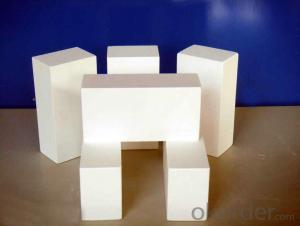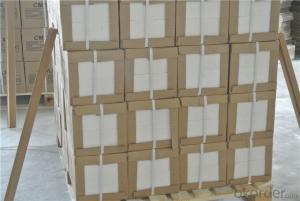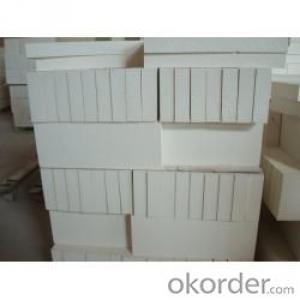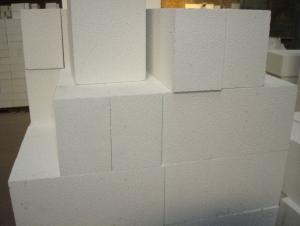Good Thermal Insulation Refractory Fire Clay Brick for Melting Furnace
- Loading Port:
- Shanghai
- Payment Terms:
- TT OR LC
- Min Order Qty:
- 1 m.t.
- Supply Capability:
- 1000 m.t./month
OKorder Service Pledge
OKorder Financial Service
You Might Also Like
Thermal Insulation Fire Clay Brick
Refractory brick is a block of refractory ceramic material used in lining furnaces, kilns, fireboxes, and fireplaces.
We provide high quality Refractory Fire Bricks that are used on wide range in the various industries like Cement, Glass and Steel. Refractory Fire Bricks are provided as per the quantity and specifications required by the customers. We provide an extensive range of Refractory Fire Bricks at reasonable prices that depend upon the quantity ordered.
Application
Insulating Fire Brick are used for the lining of converter, alternating current arc furnace, direct Current arc furnace and the ladle slag line, etc.
Company Advantage
(1)Long Insulating Fire Brick manufacture history: 25 years manufacturer
(2)Advanced equipment
(3)Diversification of production standards: ISO ANSI FEPA JIS ASTM
(4)Flexible payment: T/T L/C D/P D/A
(5)Professional marketing team and after-sale service
Insulating Fire Brick main feature:
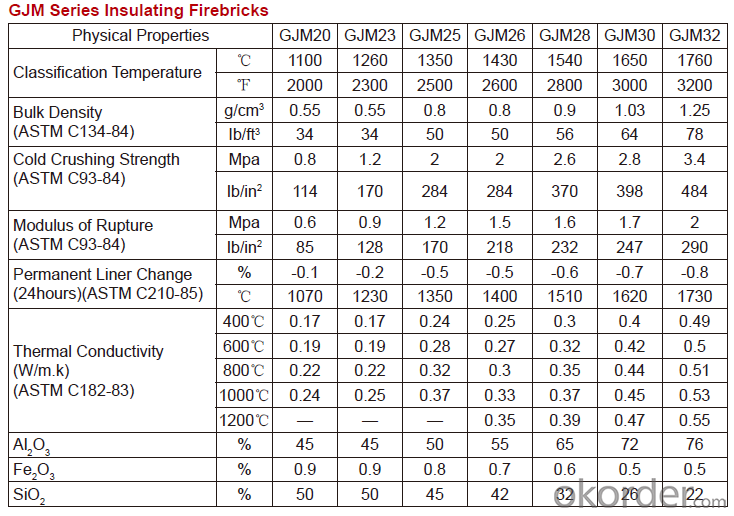
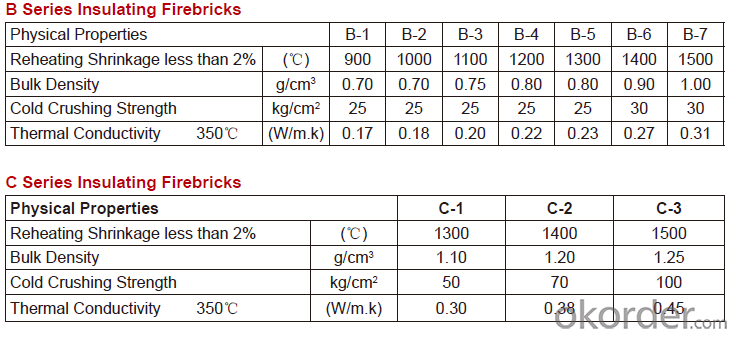
Equipment
1 unit of Ceramic Abrasive (SG Abrasive) pilot production line
2 units of Compact grain Abrasive pilot production lines
1 unit of high-end coated abrasives (abrasive cloth) production line
2 units of Boron Carbide production lines
3 large flexible crushing and sieving lines for grit production lines
6 units of 5000KVA-10000KVA dumping type electric arc furnaces for Brown Fused Alumina fusion
Q1 What’s the transport method?
A1 FCL delivery goods with wooden pallet or wooden case by sea; If LCL delivery, must with wooden case; Sometimes need open top, flat rack or bulk cargo.
Q2 What’s the required payment term?
A2 Generally 30% TT as the prepayment, 70% TT before delivery. If need, 100% Irrevocable Letter of Credit or negotiation.
Q3 Which country are our products exported to?
A3 Apart from entire Chinese market, the US, Russia, Japan, Korea, Australia and some Southeast Asian Nations.
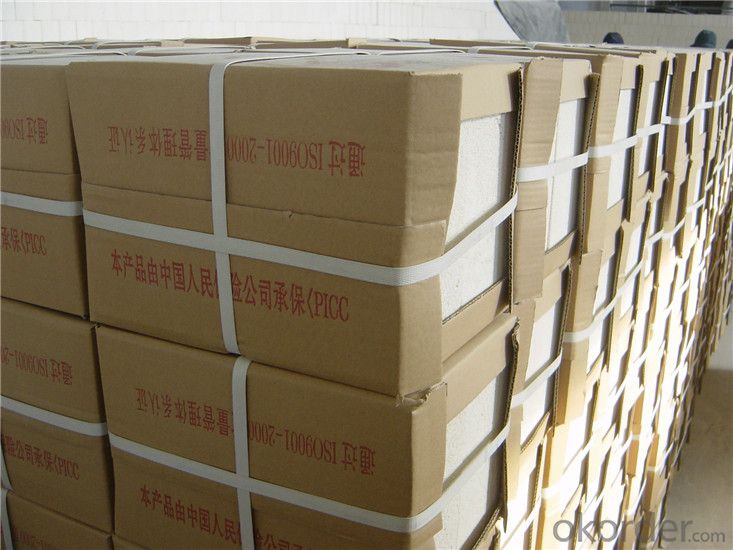

- Q:What kind of material is clay insulation refractory brick made of?
- Alumina silicate refractories with a content of 30% ~ 46% are called clayey refractories. Clay products are mainly made of mullite, glass phase, square quartz and quartz.
- Q:Are insulating fire bricks suitable for use in glass melting furnaces?
- Depending on the requirements of the furnace and the type of glass being melted, insulating fire bricks may be a suitable option for glass melting furnaces. These fire bricks are constructed from lightweight materials that have low thermal conductivity, enabling them to effectively retain heat and minimize energy loss in the furnace. This, in turn, can enhance the furnace's energy efficiency and decrease operational expenses. Nevertheless, it is essential to take into account the temperature and atmosphere within the glass melting furnace when selecting the appropriate insulating fire bricks. Glass melting furnaces function at extremely high temperatures, often surpassing 1500°C (2732°F). Some insulating fire bricks may not be capable of enduring such elevated temperatures and could deteriorate or even melt under these circumstances. Furthermore, the atmosphere within the glass melting furnace can influence the suitability of the insulating fire bricks. Certain types of these fire bricks may interact with specific gases or chemicals present in the furnace atmosphere, leading to degradation or contamination of the molten glass. Hence, it is crucial to choose insulating fire bricks that are compatible with the precise atmosphere and conditions within the glass melting furnace. To summarize, insulating fire bricks can be appropriate for use in glass melting furnaces, but careful consideration must be given to their temperature resistance and compatibility with the furnace atmosphere. Seeking guidance from specialists or suppliers who specialize in refractory materials for glass melting furnaces can help ensure the appropriate selection of insulating fire bricks for optimal furnace performance and glass quality.
- Q:What are the main components of insulating fire bricks?
- Insulating fire bricks usually consist of a blend of alumina, silica, and assorted lightweight additives. Alumina (Al2O3) is crucial in insulating fire bricks due to its ability to withstand high temperatures and resist thermal shock. Silica (SiO2) contributes to improving the refractory qualities and insulation abilities of the bricks. Furthermore, vermiculite or perlite, which are lightweight additives, are commonly incorporated to enhance the insulating properties of the bricks. The collaboration of these components produces a material that possesses exceptional thermal insulation, minimal thermal conductivity, and remarkable heat resistance.
- Q:Can insulating fire bricks be used for insulation in furnaces?
- Indeed, insulation in furnaces can be achieved by utilizing insulating fire bricks. Constructed from lightweight materials like clay and minerals, these bricks possess exceptional thermal insulation characteristics. Specifically designed to endure intense temperatures, they are well-suited for furnace applications. By impeding heat leakage from the furnace, these bricks aid in diminishing heat loss and heightening energy efficiency. Furthermore, insulating fire bricks serve to safeguard the furnace's external structure from excessive heat, thereby prolonging its lifespan. All in all, when it comes to insulation in furnaces, insulating fire bricks are a dependable and efficient option.
- Q:Are insulating fire bricks resistant to metal penetration?
- Yes, insulating fire bricks are resistant to metal penetration. These bricks are designed to have low thermal conductivity and high refractoriness, making them an effective barrier against the penetration of molten metal.
- Q:Can insulating fire bricks be used in ceramic industry kilns?
- Yes, insulating fire bricks can be used in ceramic industry kilns. These bricks are designed to withstand high temperatures and provide excellent insulation, making them suitable for use in kilns where high heat retention and energy efficiency are important.
- Q:Are insulating fire bricks resistant to salt attack?
- Yes, insulating fire bricks are generally resistant to salt attack. They have a high resistance to chemical reactions and can withstand exposure to salts without significant deterioration.
- Q:How do insulating fire bricks help improve the efficiency of heating systems?
- Insulating fire bricks help improve the efficiency of heating systems by reducing heat loss. These bricks are designed to have low thermal conductivity, which means they can effectively trap and retain heat within the heating system. By minimizing heat loss, insulating fire bricks help the heating system operate more efficiently, requiring less energy to maintain the desired temperature.
- Q:How do insulating fire bricks affect the overall fire rating of a structure?
- The overall fire rating of a structure is greatly influenced by the use of insulating fire bricks. These bricks are specifically designed to provide effective thermal insulation, thus reducing heat transfer and the risk of fire propagation. Incorporating insulating fire bricks into the construction of walls, ceilings, and floors significantly enhances the structural integrity of the building. The insulating properties of these bricks limit the spread of fire by reducing heat conduction through building materials. This is achieved through the presence of tiny air pockets within the bricks that act as insulating barriers. As a result, the temperature rise on the non-exposed side of the wall or floor is minimized, preventing the rapid spread of fire to other areas of the structure. In addition to their thermal insulation capabilities, insulating fire bricks are also highly resistant to high temperatures. This allows them to maintain their structural integrity even when exposed to intense heat, making them highly resistant to fire damage. Using these bricks in critical areas such as fire-rated walls, doors, and fireplaces significantly improves the overall fire rating of a structure. Furthermore, insulating fire bricks offer additional benefits such as soundproofing, energy efficiency, and durability. They reduce sound transmission, creating a quieter environment inside the structure. Their excellent insulation properties also minimize heat loss or gain, resulting in lower heating and cooling costs. Additionally, their resistance to thermal shock and chemical corrosion ensures a long-lasting and reliable fire barrier. To conclude, insulating fire bricks play a crucial role in enhancing the overall fire rating of a structure. Their exceptional thermal insulation properties and ability to withstand high temperatures contribute to preventing the rapid spread of fire and minimizing fire damage. Incorporating these bricks into the construction of walls, ceilings, and floors significantly improves the fire safety of a building, providing occupants with valuable evacuation time and minimizing property loss.
- Q:Do insulating fire bricks have a high electrical resistivity?
- Yes, insulating fire bricks typically have a high electrical resistivity. The high resistivity of these bricks helps to prevent the flow of electric current, making them suitable for insulation purposes in various applications.
1. Manufacturer Overview |
|
|---|---|
| Location | |
| Year Established | |
| Annual Output Value | |
| Main Markets | |
| Company Certifications | |
2. Manufacturer Certificates |
|
|---|---|
| a) Certification Name | |
| Range | |
| Reference | |
| Validity Period | |
3. Manufacturer Capability |
|
|---|---|
| a)Trade Capacity | |
| Nearest Port | |
| Export Percentage | |
| No.of Employees in Trade Department | |
| Language Spoken: | |
| b)Factory Information | |
| Factory Size: | |
| No. of Production Lines | |
| Contract Manufacturing | |
| Product Price Range | |
Send your message to us
Good Thermal Insulation Refractory Fire Clay Brick for Melting Furnace
- Loading Port:
- Shanghai
- Payment Terms:
- TT OR LC
- Min Order Qty:
- 1 m.t.
- Supply Capability:
- 1000 m.t./month
OKorder Service Pledge
OKorder Financial Service
Similar products
New products
Hot products
Related keywords
